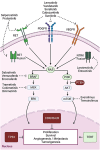Emerging therapeutic options for follicular-derived thyroid cancer in the era of immunotherapy
- PMID: 38868771
- PMCID: PMC11167082
- DOI: 10.3389/fimmu.2024.1369780
Emerging therapeutic options for follicular-derived thyroid cancer in the era of immunotherapy
Abstract
Although most follicular-derived thyroid cancers are well differentiated and have an overall excellent prognosis following treatment with surgery and radioiodine, management of advanced thyroid cancers, including iodine refractory disease and poorly differentiated/undifferentiated subtypes, is more challenging. Over the past decade, better understanding of the genetic drivers and immune milieu of advanced thyroid cancers has led to significant progress in the management of these patients. Numerous targeted kinase inhibitors are now approved by the U.S Food and Drug administration (FDA) for the treatment of advanced, radioiodine refractory differentiated thyroid cancers (DTC) as well as anaplastic thyroid cancer (ATC). Immunotherapy has also been thoroughly studied and has shown promise in selected cases. In this review, we summarize the progress in the understanding of the genetic landscape and the cellular and molecular basis of radioiodine refractory-DTC and ATC, as well as discuss the current treatment options and future therapeutic avenues.
Keywords: immunotherapy; mutational landscape; targeted therapy; thyroid cancer; tumor immune microenvironment.
Copyright © 2024 Turner, Hamidi, Ouni, Rico, Henderson, Puche, Alekseev, Colunga-Minutti, Zafereo, Lai, Kim, Cabanillas and Nurieva.
Conflict of interest statement
MC has received grant funding from Genentech and Merck and has received consulting fees from Bayer. MC on advisory board for Exelixis and Lilly. SL is medical affairs consultant with Cardinal Health. MZ has research grant funding from Eli Lilly and Merck. The remaining authors declare that the research was conducted in the absence of any commercial or financial relationships that could be construed as a potential conflict of interest.
Figures



Similar articles
-
Differentiated Thyroid Cancer-Treatment: State of the Art.Int J Mol Sci. 2017 Jun 17;18(6):1292. doi: 10.3390/ijms18061292. Int J Mol Sci. 2017. PMID: 28629126 Free PMC article.
-
ENDOCAN TUTHYREF network consensus recommendations: Refractory follicular-derived thyroid cancer.Ann Endocrinol (Paris). 2025 Jul;86(4):101735. doi: 10.1016/j.ando.2025.101735. Epub 2025 May 7. Ann Endocrinol (Paris). 2025. PMID: 40345488
-
Exploring the role of immunotherapy in the management of follicular cell-derived thyroid cancer.Immunotherapy. 2025 Jan;17(1):47-55. doi: 10.1080/1750743X.2025.2455922. Epub 2025 Feb 3. Immunotherapy. 2025. PMID: 39895320 Review.
-
Brain Metastases in Differentiated Thyroid Cancer: Clinical Presentation, Diagnosis, and Management.Thyroid. 2024 Oct;34(10):1194-1204. doi: 10.1089/thy.2024.0240. Epub 2024 Sep 4. Thyroid. 2024. PMID: 39163020 Review.
-
Increased Progression-Free Survival with Cabozantinib Versus Placebo in Patients with Radioiodine-Refractory Differentiated Thyroid Cancer Irrespective of Prior Vascular Endothelial Growth Factor Receptor-Targeted Therapy and Tumor Histology: A Subgroup Analysis of the COSMIC-311 Study.Thyroid. 2024 Mar;34(3):347-359. doi: 10.1089/thy.2023.0463. Epub 2024 Jan 23. Thyroid. 2024. PMID: 38062732 Free PMC article. Clinical Trial.
Cited by
-
Research trends and hotspots of radioiodine-refractory thyroid cancer treatment in the twenty-first century: a bibliometric analysis.Ann Nucl Med. 2025 Jan;39(1):9-20. doi: 10.1007/s12149-024-01998-2. Epub 2024 Nov 5. Ann Nucl Med. 2025. PMID: 39499416 Free PMC article.
-
Advances in the Diagnosis and Treatment of Follicular Thyroid Carcinoma: A Comprehensive Review.Cureus. 2024 Aug 5;16(8):e66186. doi: 10.7759/cureus.66186. eCollection 2024 Aug. Cureus. 2024. PMID: 39233966 Free PMC article. Review.
-
The Revolution of Targeted Therapies in Thyroid Cancer Treatment: Present and Future Promising Anti-Cancer Drugs.Int J Mol Sci. 2025 Apr 12;26(8):3663. doi: 10.3390/ijms26083663. Int J Mol Sci. 2025. PMID: 40332222 Free PMC article. Review.
-
Thyroid Cancer: Epidemiology, Classification, Risk Factors, Diagnostic and Prognostic Markers, and Current Treatment Strategies.Int J Mol Sci. 2025 May 28;26(11):5173. doi: 10.3390/ijms26115173. Int J Mol Sci. 2025. PMID: 40507982 Free PMC article. Review.
References
-
- Surveillance, Epidemiology, and End Results (SEER) Program . SEER*Stat database. Bethesda, MD: National Cancer Institute, DCCPS, Surveillance Research Program; (2023).
-
- SEER Cancer Stat Facts . Thyroid cancer. Bethesda, MD: National Cancer Institute; (2023).
Publication types
MeSH terms
Substances
Grants and funding
LinkOut - more resources
Full Text Sources
Research Materials
Miscellaneous

